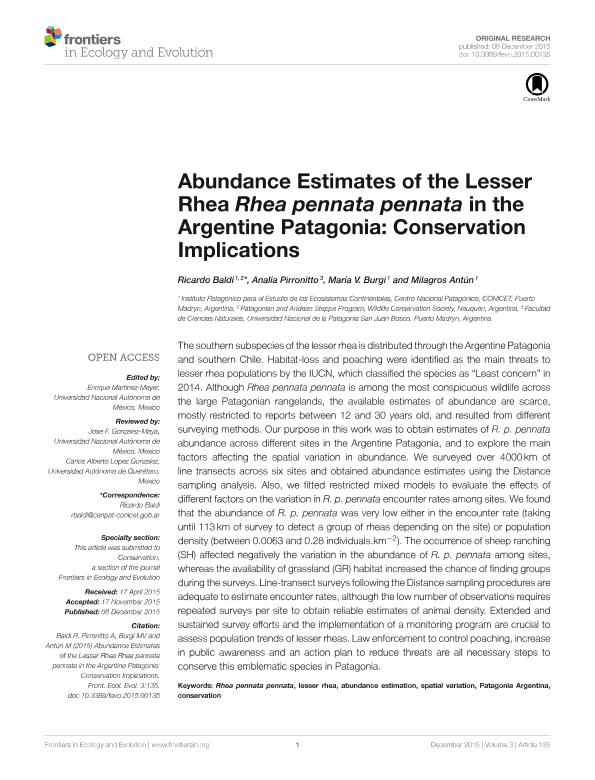Artículo
Abundance estimates of the lesser rhea Rhea pennata pennata in the Argentine Patagonia: conservation implications
Fecha de publicación:
12/2015
Editorial:
FRONTIERS IN ECOLOGY AND EVOLUTION
Revista:
FRONTIERS
ISSN:
2296-701X
Idioma:
Inglés
Tipo de recurso:
Artículo publicado
Clasificación temática:
Resumen
The southern subspecies of the lesser rhea is distributed through the Argentine Patagonia and southern Chile. Habitat-loss and poaching were identified as the main threats to lesser rhea populations by the IUCN, which classified the species as "Least concern" in 2014. Although Rhea pennata pennata is among the most conspicuous wildlife across the large Patagonian rangelands, the available estimates of abundance are scarce, mostly restricted to reports between 12 and 30 years old, and resulted from different surveying methods. Our purpose in this work was to obtain estimates of R. p. pennata abundance across different sites in the Argentine Patagonia, and to explore the main factors affecting the spatial variation in abundance. We surveyed over 4000 km of line transects across six sites and obtained abundance estimates using the Distance sampling analysis. Also, we fitted restricted mixed models to evaluate the effects of different factors on the variation in R. p. pennata encounter rates among sites. We found that the abundance of R. p. pennata was very low either in the encounter rate (taking until 113 km of survey to detect a group of rheas depending on the site) or population density (between 0.0063 and 0.28 individuals.km−2). The occurrence of sheep ranching (SH) affected negatively the variation in the abundance of R. p. pennata among sites, whereas the availability of grassland (GR) habitat increased the chance of finding groups during the surveys. Line-transect surveys following the Distance sampling procedures are adequate to estimate encounter rates, although the low number of observations requiresrepeated surveys per site to obtain reliable estimates of animal density. Extended and sustained survey efforts and the implementation of a monitoring program are crucial to assess population trends of lesser rheas. Law enforcement to control poaching, increase in public awareness and an action plan to reduce threats are all necessary steps to conserve this emblematic species in Patagonia.
Archivos asociados
Licencia
Identificadores
Colecciones
Articulos(IPEEC)
Articulos de INSTITUTO PATAGONICO PARA EL ESTUDIO DE LOS ECOSISTEMAS CONTINENTALES
Articulos de INSTITUTO PATAGONICO PARA EL ESTUDIO DE LOS ECOSISTEMAS CONTINENTALES
Citación
Baldi, Ricardo; Pirronitto, Analia; Burgi, Maria Virginia; Antun, Maria de Los Milagros; Abundance estimates of the lesser rhea Rhea pennata pennata in the Argentine Patagonia: conservation implications; FRONTIERS IN ECOLOGY AND EVOLUTION; FRONTIERS; 3; 135; 12-2015; 1-8
Compartir
Altmétricas




